Scranalogue has moved to www.scran.ac.uk/scranalogue,
May 15, 2017
by Scran
0 comments

May 15, 2017
by Scran
0 comments
Scranalogue has moved to www.scran.ac.uk/scranalogue,
April 4, 2016 by Scran | 0 comments
What do Elvis Presley, Toad of Toad Hall, Dennis the Menace, the residents of Ramsay Street, World Maths Day, coming-of-age film ‘The Breakfast Club’, and Scottish architects William Playfair, Basil Spence and Archibald Simpson have in common?
They all feature in the entries of ‘366 Days of Architecture’, a project that every day comes up with an image in the national record, Canmore, that relates to a fact specific to that day. It’s one of Historic Environment Scotland’s contributions to the 2016 Festival of Architecture, for the Scottish Government’s Year of Architecture, Innovation and Design. And it’s happening every day this year.
The image of the day can tie in with any associated event and demonstrates that diversity of digitised images in Canmore. The whole year has already been pretty much mapped out and related events include anniversaries, birthdays, sporting competitions, the signs of the zodiac and saints’ days. The big names in Scottish architecture all feature in the project, along with links to their entries in the Dictionary of Scottish Architects. Similarly, images connected to non-architectural historic events, current sporting championships and popular culture also crop up throughout the calendar. Social media is very much at the heart of ‘366 Days of Architecture’ and staff from the Communications team and Architecture and Industry section of the HES Survey and Recording group have been working together to deliver the project. The daily image is tweeted on the twitter feed @rcahms, with a link to Canmore.
Neil Gregory, Operational Manager for Architecture and Industry, and curator of January and March’s entries to date said: ‘The great thing about Canmore is that it features buildings that connect with anybody and everybody. Architecture has a place in everyone’s lives and buildings form a backdrop to every tangible cultural event. We hope that 366 Days of Architecture will bring new audiences to Canmore, entertain our current users and the wider public who enjoy using Twitter’
He added: ‘The great thing about the project is that there are always bags of images, film clips and sound snippets in Scran so we’ve had great fun finding complementary material on the Scran website. An event like the 1972 Eurovision Song Contest that took place at the Usher Hall in Edinburgh gives us a chance to showcase 1910 designs for the building that were never realised on Canmore and pictures of the contest happening that are held within Scran’
Clare Sorensen, Architecture and Industry Projects Manager, and curator of February and April’s entries to date added: ‘The project is a real showcase for the historic collections that we care for here at HES as well as the sheer variety of buildings that we have recorded as part of our survey projects. We’ve so far featured buildings recorded in the early 20th century in RCAHMS’ infancy as well as sites that we’ve investigated in the last few months as part of the new organisation’
‘366 Days of Architecture’ can be accessed via the daily tweet from @rcahms or directly from the front page of Canmore. To find out more about what’s happening in the Festival of Architecture, including other HES contributions, check out https://www.foa2016.com/
Images © Scottish Exhibitions Study Group, Crown Copyright: Historic Environment Scotland, The Scotsman | Licensor Scran
March 18, 2016 by Scran | 0 comments
And many of these offer access to Scran not just in branch, but as an online resource available from home. Check if you have free access here.
Image – Book exhibition in Signet Library, 1956 © The Scotsman Publications Ltd . Licensor www.scran.ac.uk
January 26, 2016 by Scran | 1 Comment
 Holocaust Memorial Day, 27 January, is the day for everyone to remember the millions of Jews murdered during the Holocaust, and the millions of people killed Nazi Persecution throughout World War Two.
Holocaust Memorial Day, 27 January, is the day for everyone to remember the millions of Jews murdered during the Holocaust, and the millions of people killed Nazi Persecution throughout World War Two.
In recent years, the Gathering the Voices Association has been collecting and recording survivor’s stories – some came on the Kindertransport, meanwhile others survived concentration camps and many made remarkable journeys to get to safety in Scotland.
 One such person was Marion Camrass; her story begins in Poland 1932. She was born into a wealthy family in Krakow. As a child during World War Two she fled the fighting by travelling into Soviet Russia and eventually to Siberia, Kazakhstan and Uzbekistan. In 1946 she joined her aunt in Glasgow, where she completed her school education, went to university and finally settled.
One such person was Marion Camrass; her story begins in Poland 1932. She was born into a wealthy family in Krakow. As a child during World War Two she fled the fighting by travelling into Soviet Russia and eventually to Siberia, Kazakhstan and Uzbekistan. In 1946 she joined her aunt in Glasgow, where she completed her school education, went to university and finally settled.
 We are delighted to say the Gathering the Voices Association has shared a selection of material with Scran, becoming our newest contributing partner.
We are delighted to say the Gathering the Voices Association has shared a selection of material with Scran, becoming our newest contributing partner.
Now you can listen to the interviews on Scran, not only the story of Marion Camrass but also that of Gretl Shapiro – hear all about their lives in Scotland after World War Two. Each interview has a full transcript available for reference and fascinating, accompanying images.
There are also supporting materials on topics such as religious discrimination and sectarianism.
Images © Gathering the Voices
January 22, 2016 by Scran | 0 comments
 This term in Perth & Kinross, two schools are working in partnership with Scran to focus on Expressive Arts. Both Abernethy Primary School & Dunbarney Primary School are taking a whole school approach to teaching Art & Design.
This term in Perth & Kinross, two schools are working in partnership with Scran to focus on Expressive Arts. Both Abernethy Primary School & Dunbarney Primary School are taking a whole school approach to teaching Art & Design.
Before Christmas staff came together for the project brief. The challenge was to come up with common schemes of work for each year group, across both schools. Below are the topics each year group is investigating at present;

As well as these Studying Scotland themes, classes will be identifying opportunities for IDL. Significant aspects of learning and progression pathways are being addressed throughout the teaching & learning activities which are currently underway. This area for development is set to conclude during mid February, when both schools will exhibit the pupil outcomes, inviting parents to come in to celebrate the pupils’ achievement.
 Evaluation & moderation is an integral part of the project. Exemplars of pupils’ work will then be used during InSET on as the basis for a school Art & Design moderation. Scran continues to provide support, subject specific knowledge and will also be doing Kite Aerial Photography, as an extension activity during the Spring with selected classes. We’ll keep you posted on their progress & share some of the outcomes in the coming weeks.
Evaluation & moderation is an integral part of the project. Exemplars of pupils’ work will then be used during InSET on as the basis for a school Art & Design moderation. Scran continues to provide support, subject specific knowledge and will also be doing Kite Aerial Photography, as an extension activity during the Spring with selected classes. We’ll keep you posted on their progress & share some of the outcomes in the coming weeks.November 10, 2015 by Scran | 0 comments
On the road again in Cyprus, so what did we do with Archnetwork today ?
S aturday 19th September 2015. After such a full day in the capital, we stayed local and visited the neighbouring village of Kato Drys. Firstly, we went to the top of Sotira hill, behind Lefkara to get panoramic view across the Larnaca District and surrounding landscape and visited the tiny church perched there. It had some charming icons dating from the early C20th.
aturday 19th September 2015. After such a full day in the capital, we stayed local and visited the neighbouring village of Kato Drys. Firstly, we went to the top of Sotira hill, behind Lefkara to get panoramic view across the Larnaca District and surrounding landscape and visited the tiny church perched there. It had some charming icons dating from the early C20th.
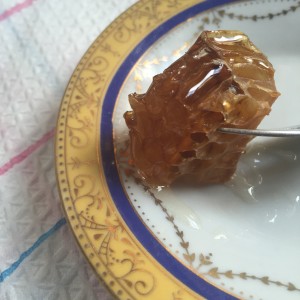
Next stop was by an ancient oak and some knarly, old olive trees. We heard from Martin some local folklore about village rivalry & how the village took its name from the many “Dryes” (oaks) that grew in the area. Martin also informed us about community efforts to sew acorns & regenerate some of these magnificent trees.
We had the pleasure of visiting house of Elli Papachristoforou, who generously let us sample some of her honey which was rather special. She then gave us a guided tour of both the (Embroidery) Museum of Folk Art and the (Bee) Agricultural Museum of Kato Drys. Both were captivating and provided further context for everything we had learned over the previous days in respect of Cypriot culture, nature, social & economic growth. The homestead of Reo Stakis was pointed out to us, the famous son of the village who built the Stakis Hotels empire.
* * *
Sunday 20th September 2015. In the capable hands of our host for the day, Adriana Patkova, we wove our way through the twisty mountain roads of Cyprus, spotting beehives, bikers, wind turbines, reservoirs, solar farms, eucalyptus trees, terraces & an asbestos mine.

I took issue with the interpretation on site, there was the distinct lack of information about the hazards of asbestos & the effects on the nearby mining villages as clearly studied in here.  Report on the Health Effects of the Asbestos Mines on the … Some advice for visitors poking around in the rocks would not go amiss. Contaminated land from historical mining in Cyprus is an issue. The Amiantos Asbestos Mine in the Troodos National Park, where we stopped is undergoing restoration. The biodiversity conservation, restoration and management project concludes at the end of December 2015.
Report on the Health Effects of the Asbestos Mines on the … Some advice for visitors poking around in the rocks would not go amiss. Contaminated land from historical mining in Cyprus is an issue. The Amiantos Asbestos Mine in the Troodos National Park, where we stopped is undergoing restoration. The biodiversity conservation, restoration and management project concludes at the end of December 2015.
Moving on.  We arrived at picturesque Agros where we visited a smokery, had a peek into the smoking room at Kafkalia and sampled their products; posirti, lountza, loukanika, hiromeri, zalatina, tsamarelle and pastourmas. After lunch we continued to climb to the top, reaching Troodos Square we couldn’t help but notice the familiar environment, it looked like Scotland! There was a thistle to prove it. The British military presence was again, all around. We went to the rather dated visitor centre and proceeded to Pano Platres where we saw a peculiar post box. Finally we had a long drive, down to the coast and back to Lefkara with a pit stop in Zygi.
We arrived at picturesque Agros where we visited a smokery, had a peek into the smoking room at Kafkalia and sampled their products; posirti, lountza, loukanika, hiromeri, zalatina, tsamarelle and pastourmas. After lunch we continued to climb to the top, reaching Troodos Square we couldn’t help but notice the familiar environment, it looked like Scotland! There was a thistle to prove it. The British military presence was again, all around. We went to the rather dated visitor centre and proceeded to Pano Platres where we saw a peculiar post box. Finally we had a long drive, down to the coast and back to Lefkara with a pit stop in Zygi.
Monday 21st September, our final day.  We made an early morning visit to the silversmiths in Lefkara and learned about their processes, which are mostly mechanised but involved all sorts of materials, rubber, wax, plaster and of course silver. The workshops were very interesting but we could not linger. Adriana had to get us to the airport for our incredible journey home to Glasgow, via Stansted. I’m glad to say on our way to Paphos she took us to see Aphrodite’s Rock, the ideal way to say goodbye & ευχαριστώ
We made an early morning visit to the silversmiths in Lefkara and learned about their processes, which are mostly mechanised but involved all sorts of materials, rubber, wax, plaster and of course silver. The workshops were very interesting but we could not linger. Adriana had to get us to the airport for our incredible journey home to Glasgow, via Stansted. I’m glad to say on our way to Paphos she took us to see Aphrodite’s Rock, the ideal way to say goodbye & ευχαριστώ
The experiences of this week were fascinating. From knowing very little about Cyprus I now feel after this cultural exchange that I have gained a decent understanding of Cypriot life, both contemporary and traditional.
Everybody we encountered was genuinely friendly & extremely welcoming. I found more personal parallels with the socio-political divide in the country than I expected. The cuisine was fabulous, the crafts exquisite, the landscape so dry and different & the company… well, we had a lot of fun too.
Imagery © Newsquest, Licensor Scran & J.Sangster
November 2, 2015 by Scran | 0 comments
Another instalment from our education officer’s report on the Archnetwork Erasmus+ course, Empowering Communities in Cyprus.
Friday 18th September 2015. Today started with a trip into the countryside for breakfast. On our way a black snake slid across the road in front of us, apparently a large Whip-Snake, quite a sight. At Loulla’s Farm we found out how Cypriot cheese is made, we had a demonstration of how the goats’ milk is treated, brined and stored to producehalloumi – yum! The process was straightforward with the addition of a pinch of mint and a vacuum pack, done. Outside there was a cheese safe containing what I believe was maturing kefalotyri, another Cypriot delight. We got to visit the goats & even meet a day old kid. Now we were ready to see Lefkosia or Nicosia, on both sides.
N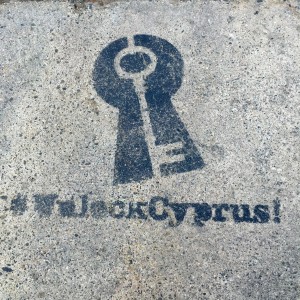 earing the capital city of Cyprus I was surprised to see a giant Turkish Cypriot flag painted onto the side of the Kyrenia Mountains – what a statement. Following the conflict of 1974, the Turkish Republic of Northern Cyprus TRNC became a self-declared state, however it is only recognised by Turkey. The political and military dispute in Cyprus remains unresolved and the island continues with life, divided. The Green Line runs 112 miles from east to west across the island, splitting families, property and communities.
earing the capital city of Cyprus I was surprised to see a giant Turkish Cypriot flag painted onto the side of the Kyrenia Mountains – what a statement. Following the conflict of 1974, the Turkish Republic of Northern Cyprus TRNC became a self-declared state, however it is only recognised by Turkey. The political and military dispute in Cyprus remains unresolved and the island continues with life, divided. The Green Line runs 112 miles from east to west across the island, splitting families, property and communities.
We parked by the C16th Venetian city walls and continued on foot through the narrow back streets to our first destination, Helen’s of Kyrenia, a lace shop at 33 Ippokratous. The stock in the shop dated back decades. To my delight amongst the heaps of lace, tatting & embroidery, I found a packet which explained the provenance of the Lefkara lace within; Guarantee Hand Made – Made in Cyprus – Irish Linen – French Thread. Perfect.
Despite the daily impasse, the people of Nicosia go about their business as usual, at least on the surface. Once you start to look around however there are clues on the streets. Still on the south side of the city, we began to notice thought provoking graffiti, not unlike the imagery that adorns the barrier walls of Bethlehem or indeed the peace lines of Belfast. When people live conflict every day for 40+ years, it cannot be ignored. at the time The Scotsman newspaper reported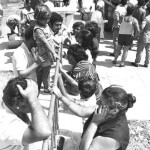 on the Turkish-Cypriot war & is documented with poignant imagery from 1974. (Image © The Scotsman. Licensor Scran)
on the Turkish-Cypriot war & is documented with poignant imagery from 1974. (Image © The Scotsman. Licensor Scran)
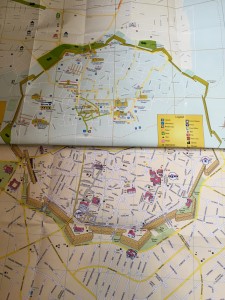 Nicosia is a vibrant & sophisticated city, with a buzz in the streets. Trendy shops & coffee houses lined the artists’ quarter. After a little pick-me-up in the form of some Cyprus coffee, μέτριο for me please, we neared the Green Line. Passports at the ready we crossed over to the north side of the city through two sets of border control, Greek & Turkish. It was easy enough the pass through, plenty of tourists and locals alike were going to & fro. Yet, CCTV was evident, uniformed armed guards were on duty & signage warned us that photography was strictly forbidden in this narrow
Nicosia is a vibrant & sophisticated city, with a buzz in the streets. Trendy shops & coffee houses lined the artists’ quarter. After a little pick-me-up in the form of some Cyprus coffee, μέτριο for me please, we neared the Green Line. Passports at the ready we crossed over to the north side of the city through two sets of border control, Greek & Turkish. It was easy enough the pass through, plenty of tourists and locals alike were going to & fro. Yet, CCTV was evident, uniformed armed guards were on duty & signage warned us that photography was strictly forbidden in this narrow slice of no-man’s land. The freely available maps of the city tell their own story, both versions simply do not show basic information on their enemy’s side. Visitors must use not one, but two, maps to see the lay of the land and get their bearings in Nicosia.
slice of no-man’s land. The freely available maps of the city tell their own story, both versions simply do not show basic information on their enemy’s side. Visitors must use not one, but two, maps to see the lay of the land and get their bearings in Nicosia.
 Once we had crossed the Green Line we made our way to the breath-taking Buyuk Han or Grand Inn. It as built in 1572 by the Ottomans and was been restored to it’s former glory in the 1990s. The contrast in the city was immediately apparent. We passed by the intriguing Selimiye Mosque as the call to prayer rang out. Formerly it was the Cathédrale Sainte Sophie, so architecturally & spiritually it has been re-purposed.
Once we had crossed the Green Line we made our way to the breath-taking Buyuk Han or Grand Inn. It as built in 1572 by the Ottomans and was been restored to it’s former glory in the 1990s. The contrast in the city was immediately apparent. We passed by the intriguing Selimiye Mosque as the call to prayer rang out. Formerly it was the Cathédrale Sainte Sophie, so architecturally & spiritually it has been re-purposed.  The result is an odd juxtapostion of east meets west – gothic grandeur, flying buttresses with minarets and ornate window grills. I even spotted a Green man lurking in the masonry over the entrance. Also by the main door there was a suspiciously Scottish looking, ironwork structure used for the washing of feet. It was not dissimilar to a bandstand, however it had obviously been re-purposed too. I was unable to find any makers mark but it was reminiscent of the products shipped around the world by The Lion Foundry of Kirkintilloch. (Image © East Dunbartonshire Council. Licensor www.scran.ac.uk.)
The result is an odd juxtapostion of east meets west – gothic grandeur, flying buttresses with minarets and ornate window grills. I even spotted a Green man lurking in the masonry over the entrance. Also by the main door there was a suspiciously Scottish looking, ironwork structure used for the washing of feet. It was not dissimilar to a bandstand, however it had obviously been re-purposed too. I was unable to find any makers mark but it was reminiscent of the products shipped around the world by The Lion Foundry of Kirkintilloch. (Image © East Dunbartonshire Council. Licensor www.scran.ac.uk.)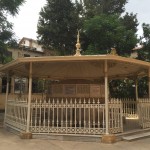
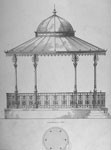
The many souvenir shops in the area were selling Turkish Delight, not Cypriot Delight, as they were just a few hundred metres away. Within the Buyuk Han, we feasted on a meze of Turkish Cypriot dishes and then visited the wonderful Senay Ekingen, at Su-Ha Tic. Senaye studied tourism in England and has run her business since 1987, making Lefkara lace in the traditional manner as well as creating new products to incorporate it, such as bags & jewellery. She also imports her base fabric from one of the last linen producing mills left in Ireland, Thomas Ferguson.
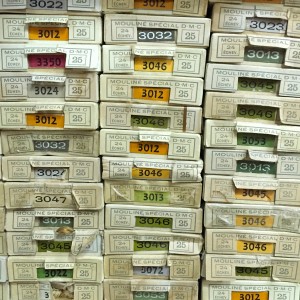 Not only is she a successful businesswoman, but Senaye also works on bi-communal projects, using craft to bring together Cypriots from both sides of the divide and trains up young apprentices too. Thereby generating hope for the future and breaking down barriers. Later we visited the amazing Yagcioglu haberdashery, which stocked the all-important DMC (Dollfus-Mieg & Compagnie) French embroidery thread for making Lefkaritika, in an extensive back catalogue of colours. (Here’s an example of embroidery on Scran using DMC thread)
Not only is she a successful businesswoman, but Senaye also works on bi-communal projects, using craft to bring together Cypriots from both sides of the divide and trains up young apprentices too. Thereby generating hope for the future and breaking down barriers. Later we visited the amazing Yagcioglu haberdashery, which stocked the all-important DMC (Dollfus-Mieg & Compagnie) French embroidery thread for making Lefkaritika, in an extensive back catalogue of colours. (Here’s an example of embroidery on Scran using DMC thread)
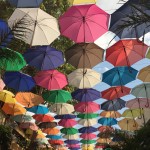 We wound our way back along the colourful Ledera Street, via the folk arts museum, stumbled on some Limassol Brick & Tile co. roof tiles for good measure & once again crossed the Green Line, pausing to look at the contemporary sculptures in our path.
We wound our way back along the colourful Ledera Street, via the folk arts museum, stumbled on some Limassol Brick & Tile co. roof tiles for good measure & once again crossed the Green Line, pausing to look at the contemporary sculptures in our path.
Imagery © J.Sangster
October 29, 2015 by User deactivated | 0 comments
 We know some of you have. At a Scran event last year we met a lady who identified one of the children featured in this photograph of Northern District School in Perth 1952 as her cousin!
We know some of you have. At a Scran event last year we met a lady who identified one of the children featured in this photograph of Northern District School in Perth 1952 as her cousin!
We’ve also met: a student who found a photograph of her father, a former football player, featured in our Scotsman collections; a librarian who found a photograph of her fisherman great-grandfather pictured in his native north-east; a lady who found a photograph of herself in the school netball team back in the 1960s.
If you’ve found any of your ancestors – or even yourself – on Scran, we’d love to hear from you. If you’d like to share your family story on Scranalogue, please comment below or get in touch with us directly at scran@scran.ac.uk.
Remember to identify the Scran image that you have a family connection with. You can do this by telling us its URL (its weblink) or by its USI number (that’s the small number that appears under each thumbnail image in search results and begins 000- and ends -C). Don’t forget to explain your connection to the image – just a few sentences will do. We’d also love to know your name and where you come from, but you can remain anonymous if you wish.
Images: © Perth Museum & Art Gallery. Licensor www.scran.ac.uk
October 27, 2015 by Scran | 0 comments
Today we are sharing the third instalment from the Archnetwork Erasmus+ course, Empowering Communities in Cyprus.
Thursday 17th September 2015. Today was a hands-on day. In the morning we journeyed 25 minutes north east of Lefkara, to the small village of Kornos.  Here we were greeted by the wonderful, women of the pottery cooperative. They provided us with a demonstration of their pot making techniques and the opportunity to make our own using the rich red terracotta clay. Coffee was served and through translation we exchanged lots of information. The unprocessed clay sat in mound by the side of the road which I found curious, so I enquired about it’s preparation, as it is heavy work. A tour of the clay mill & machinery ensued and it was explained that a local man helped with this. We looked around the store room full of fired pots in all shapes and sizes, from bee hives to cooking pots. We saw their working electric kiln. There was also an unmissable 200 year-old, brick-built, wood-fired kiln – a thing of beauty in need of restoration, which is planned. Another more dilapidated kiln sat crumbling behind the main building, seemingly beyond repair.
Here we were greeted by the wonderful, women of the pottery cooperative. They provided us with a demonstration of their pot making techniques and the opportunity to make our own using the rich red terracotta clay. Coffee was served and through translation we exchanged lots of information. The unprocessed clay sat in mound by the side of the road which I found curious, so I enquired about it’s preparation, as it is heavy work. A tour of the clay mill & machinery ensued and it was explained that a local man helped with this. We looked around the store room full of fired pots in all shapes and sizes, from bee hives to cooking pots. We saw their working electric kiln. There was also an unmissable 200 year-old, brick-built, wood-fired kiln – a thing of beauty in need of restoration, which is planned. Another more dilapidated kiln sat crumbling behind the main building, seemingly beyond repair.
The shop also served as a make shift museum, displaying photographs of the potters throughout the 20th Century when it was a much larger concern, employing many more villagers and supporting more families. Today there are no young people joining the Kornos pottery or learning the skills, so it’s long term future is uncertain.
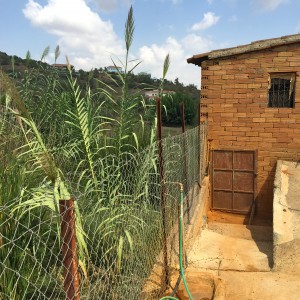 The pottery workshop facilities were very basic, partially in the open air. As we were working it struck me, the pace at which the potter’s could complete an entire pot was hastened because of the warmer climate allowed the clay to firm up much quicker than the UK. Paired with their perfectly honed building skills, the potters could produce a complete decorated piece in under an hour, to await firing in the kiln.
The pottery workshop facilities were very basic, partially in the open air. As we were working it struck me, the pace at which the potter’s could complete an entire pot was hastened because of the warmer climate allowed the clay to firm up much quicker than the UK. Paired with their perfectly honed building skills, the potters could produce a complete decorated piece in under an hour, to await firing in the kiln.
I also asked about the potters’ health, if anyone suffered from chest complaints from the clay dust, which can cause silicosis, they all shook their heads. The workshop had no extraction system, which is mandatory for health & safety in the UK. Then again, the workspace was open and ventilated by nature. I thoroughly enjoyed revisiting my pot making skills as well as meeting these great people.
In the afternoon we returned to Lefkara clutching our unfired earthenware.  It was time to apply more dexterity and attempt some Lefkara lace making. Panayiota was our patient teacher and she started us off by showing the margarite pattern. This geometric design requires precision embroidery, good eyesight for counting warp & weft threads and for a beginner, vast amounts of concentration. The instructions made perfect sense but putting it into practice was another matter. The lesson made us all appreciate Lefkaritika that wee bit more.
It was time to apply more dexterity and attempt some Lefkara lace making. Panayiota was our patient teacher and she started us off by showing the margarite pattern. This geometric design requires precision embroidery, good eyesight for counting warp & weft threads and for a beginner, vast amounts of concentration. The instructions made perfect sense but putting it into practice was another matter. The lesson made us all appreciate Lefkaritika that wee bit more.
Imagery © J.Sangster
October 22, 2015 by User deactivated | 0 comments
And many of these offer access to Scran not just in branch, but as an online resource available from home. Check if you have free access here.
Image © East Lothian Council Library Service. Licensor www.scran.ac.uk
Glow Blogs uses cookies to enhance your experience on our service. By using this service or closing this message you consent to our use of those cookies. Please read our Cookie Policy.